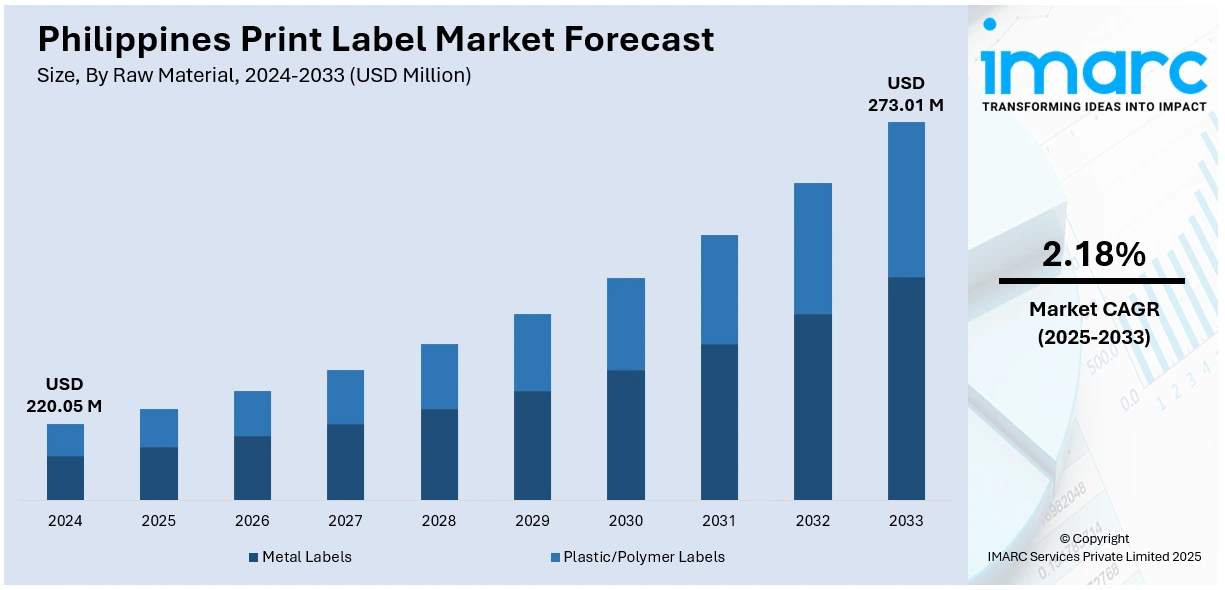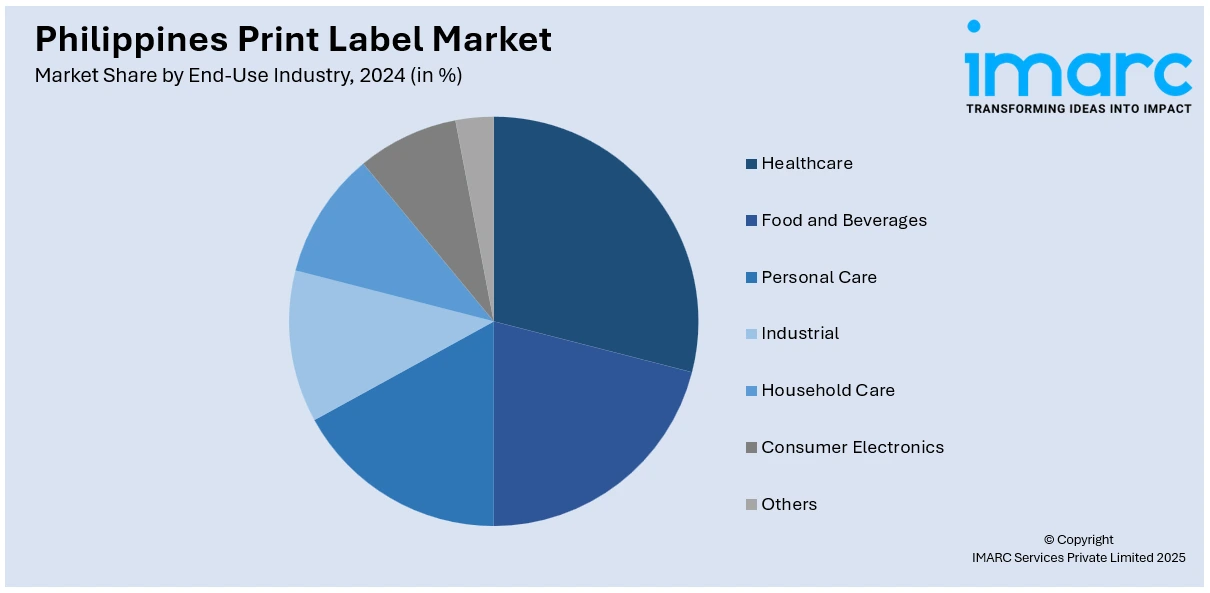
Philippines Print Label Market Size, Share, Trends and Forecast by Raw Material, Print Process, Label Format, End-Use Industry, and Region, 2026-2034
Philippines Print Label Market Overview:
The Philippines print label market size reached USD 220.05 Million in 2025. Looking forward, the market is expected to reach USD 273.01 Million by 2034, exhibiting a growth rate (CAGR) of 2.18% during 2026-2034. The market is driven by growing demand for packaged consumer products, the growth of the food and beverage sector, and an expanding pharmaceutical and personal care industry. Urbanization and the development of e-commerce are also driving demand for eye-catching, information-rich, and durable labels. Shift toward sustainable packaging is encouraging the use of eco-friendly label materials and printing solutions, further contributing to the steady expansion of the Philippines print label market share.
|
Report Attribute
|
Key Statistics
|
|---|---|
|
Base Year
|
2025
|
|
Forecast Years
|
2026-2034
|
|
Historical Years
|
2020-2025
|
| Market Size in 2025 | USD 220.05 Million |
| Market Forecast in 2034 | USD 273.01 Million |
| Market Growth Rate 2026-2034 | 2.18% |
Philippines Print Label Market Trends:
Shift Toward Digitally Printed Labels
One of the most significant trends in the Philippines print label market is the increasing adoption of digital printing technologies. While local companies focus on shorter lead times, less waste, and more design freedom, digital label printing has gained more appeal compared to conventional ones like flexography. More so for small and medium-sized enterprises (SMEs), which constitute most of the Philippine market and need affordable solutions for low-volume, high-variety product lines. Digital printing facilitates quick prototyping and enables on-demand printing, which is best suited for companies dealing with fast-moving consumer goods (FMCG), cosmetics, and specialty foods. Moreover, the development of e-commerce has caused a boom in demand for customized and eye-catching packaging, prompting printers to invest in sophisticated digital presses. Local printers are now also using variable data printing to create customized labels that maximize consumer interaction and reinforce brand awareness within an intensely competitive retail sector, which further contributes to the Philippines print label market growth and development.

To get more information on this market, Request Sample
Development of Eco-Friendly Labeling Solutions
Sustainability is becoming the defining characteristic in the Philippines print label business, as consumers and government agencies alike increasingly demand more eco-friendly procedures. Label makers are increasingly venturing into the use of recyclable, biodegradable, and compostable materials to address this growing need. In industries such as food and beverage, where packaging waste is a critical concern, brands are using eco-labels that coincide with their green marketing intentions. Additionally, the transition towards water-based and soy-based inks in place of solvent-based options is becoming more popular owing to lower environmental footprints and enhanced safety regulations. Filipino businesses are also incorporating sustainability labeling and eco-labels on their packaging to address the increasing environmental concern of local and global consumers. Such a trend is also supported by government policies that promote circular economy, rendering it a necessity for label makers to diversify and position their products to correspond with wider environmental objectives while ensuring print quality and longevity.
Growing Demand from Domestic Industries and Export-Focused Sectors
The Philippine print label industry is booming on the back of a vibrant array of domestic industries and export markets. With the gradual growth of processed foods, beverages, pharmaceuticals, and personal care products industries, demand for quality, regulatory-compliant labeling has increased tremendously. Labels are not only used for branding purposes but are also used for product information, traceability, and safety compliance, particularly in industries where labeling requirements are stringent. In addition, the active involvement of the Philippines in global trade has compelled domestic manufacturers to enhance their labeling systems to accommodate international export needs. Producers of items such as tuna, dried mangoes, coconut oil, and herbal supplements depend greatly on clear, robust, and multilingual labels in order to access global markets. This has also supported more investment in advanced labeling technologies that are accurate and consistent. Subsequently, print label service providers are expanding their capacity to meet both domestic customers and those targeting foreign market penetration.
Philippines Print Label Market Segmentation:
IMARC Group provides an analysis of the key trends in each segment of the market, along with forecasts at the country and regional levels for 2026-2034. Our report has categorized the market based on raw material, print process, label format, and end-use industry.
Raw Material Insights:
- Metal Labels
- Plastic/Polymer Labels
The report has provided a detailed breakup and analysis of the market based on the raw material. This includes metal labels and plastic/polymer labels.
Print Process Insights:
- Offset Lithography
- Gravure
- Flexography
- Screen
- Letterpress
- Electrophotography
- Inkjet
A detailed breakup and analysis of the market based on the print process have also been provided in the report. This includes offset lithography, gravure, flexography, screen, letterpress, electrophotography, and inkjet.
Label Format Insights:
- Wet-Glue Labels
- Pressure-Sensitive Labels
- Linerless Labels
- Multi-part Tracking Labels
- In-Mold Labels
- Sleeves
The report has provided a detailed breakup and analysis of the market based on the label format. This includes wet-glue labels, pressure-sensitive labels, linerless labels, multi-part tracking labels, in-mold labels, and sleeves.
End-Use Industry Insights:

- Healthcare
- Food and Beverages
- Personal Care
- Industrial
- Household Care
- Consumer Electronics
- Others
A detailed breakup and analysis of the market based on the end-use industry have also been provided in the report. This includes healthcare, food and beverages, personal care, industrial, household care, consumer electronics, and others.
Regional Insights:
- Luzon
- Visayas
- Mindanao
The report has also provided a comprehensive analysis of all the major regional markets, which includes Luzon, Visayas, and Mindanao.
Competitive Landscape:
The market research report has also provided a comprehensive analysis of the competitive landscape. Competitive analysis such as market structure, key player positioning, top winning strategies, competitive dashboard, and company evaluation quadrant has been covered in the report. Also, detailed profiles of all major companies have been provided.
Philippines Print Label Market News:
- In July 2024, Nilpeter, a worldwide provider of label and flexible packaging printing solutions, declared a new collaboration with Ferros Systemas Corp. as its official representative in the Philippines. This strategic partnership seeks to broaden Nilpeter’s footprint in the area and offer clients access to innovative printing technologies.
Philippines Print Label Market Report Coverage:
| Report Features | Details |
|---|---|
| Base Year of the Analysis | 2025 |
| Historical Period | 2020-2025 |
| Forecast Period | 2026-2034 |
| Units | Million USD |
| Scope of the Report |
Exploration of Historical Trends and Market Outlook, Industry Catalysts and Challenges, Segment-Wise Historical and Future Market Assessment:
|
| Raw Materials Covered | Metal Labels, Plastic/Polymer Labels |
| Print Processes Covered | Offset Lithography, Gravure, Flexography, Screen, Letterpress, Electrophotography, Inkjet |
| Label Formats Covered | Wet-Glue Labels, Pressure-Sensitive Labels, Linerless Labels, Multi-part Tracking Labels, In-Mold Labels, Sleeves |
| End-Use Industries Covered | Healthcare, Food and Beverages, Personal Care, Industrial, Household Care, Consumer Electronics, Others |
| Regions Covered | Luzon, Visayas, Mindanao |
| Customization Scope | 10% Free Customization |
| Post-Sale Analyst Support | 10-12 Weeks |
| Delivery Format | PDF and Excel through Email (We can also provide the editable version of the report in PPT/Word format on special request) |
Key Questions Answered in This Report:
- How has the Philippines print label market performed so far and how will it perform in the coming years?
- What is the breakup of the Philippines print label market on the basis of raw material?
- What is the breakup of the Philippines print label market on the basis of print process?
- What is the breakup of the Philippines print label market on the basis of label format?
- What is the breakup of the Philippines print label market on the basis of end-use industry?
- What is the breakup of the Philippines print label market on the basis of region?
- What are the various stages in the value chain of the Philippines print label market?
- What are the key driving factors and challenges in the Philippines print label market?
- What is the structure of the Philippines print label market and who are the key players?
- What is the degree of competition in the Philippines print label market?
Key Benefits for Stakeholders:
- IMARC’s industry report offers a comprehensive quantitative analysis of various market segments, historical and current market trends, market forecasts, and dynamics of the Philippines print label market from 2020-2034.
- The research report provides the latest information on the market drivers, challenges, and opportunities in the Philippines print label market.
- Porter's five forces analysis assist stakeholders in assessing the impact of new entrants, competitive rivalry, supplier power, buyer power, and the threat of substitution. It helps stakeholders to analyze the level of competition within the Philippines print label industry and its attractiveness.
- Competitive landscape allows stakeholders to understand their competitive environment and provides an insight into the current positions of key players in the market.
Need more help?
- Speak to our experienced analysts for insights on the current market scenarios.
- Include additional segments and countries to customize the report as per your requirement.
- Gain an unparalleled competitive advantage in your domain by understanding how to utilize the report and positively impacting your operations and revenue.
- For further assistance, please connect with our analysts.
 Request Customization
Request Customization
 Speak to an Analyst
Speak to an Analyst
 Request Brochure
Request Brochure
 Inquire Before Buying
Inquire Before Buying




.webp)




.webp)












